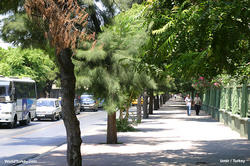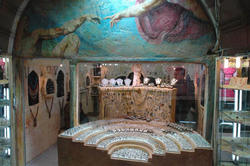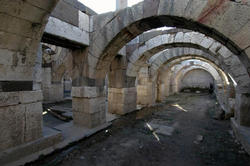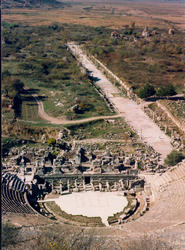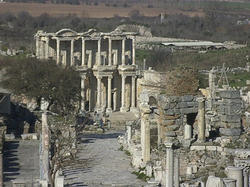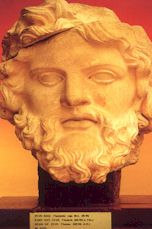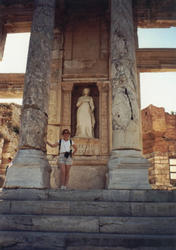Ancient cities and different places
The continuous excavations on the Bayraklı ridges by Prof. Dr. Ekrem Akurgal since 1959, the discovery of the Zeus Altar by the German archaeologist Carl Humman in Pergamon (Bergama) between 1866 and 1878, the discovery of the Seljuk Artemis Temple in 1869 by the British wood and the continuous excavations by Austrian archeologists at certain intervals of the city of ancient Ephesus since 1904.
Also many researchers in different universities are still investigating on the city’s historical development. |
 | Turkey is one of the countries in which the world railroad transportation was first practiced. The first railroad routes in turkey are the ones between Izmir- Aydın and Izmir- Turgutlu, which began working between 1856 and 1863 during the period of the Ottoman Empire after the First World War. In the years of the struggle of liberation İzmir underwent a great wreckage with great destructions and fires. With the driving away of the Greeks by the leadership of the great leader Mustafa Kemal Atatürk on September 9th 1922, Izmir started to become a modern city of the young Turkish Republic and developed this character more everyday.
Many legends are known about the derivation of the name of Izmir. According to the knowledge acquired from scientific studies the word "IZMIR" came from Smyrna in the ancient Ionian dialect and it was written as Smyrna in the Attikan (around Athens) dialect. The word Smyrna was not Greek. It came from Anatolian rootb like many other names in the Agean Region from the texts belonging to 2000 B.C. in the Kultepe settlement in Kayseri, a place called Tismyrna was come across in the (Ti) at the beginning was omitted and the city was pronounced as Smyrna. So the city was called Smyrna the early years of 3000 B.C. or late 1800 B.C In the Turkish era the city was called Izmir. | |
| Smyrna was erected on a much older city. It was captured and destroyed by Alyattes, king of Lydia, in 600 and later was reconstructed and restored. Following the defeat of the Lydians by the Persians, the latter seized it before it was eventually taken by Alexander the Great in 334 BC. |
(It is at Bayraklı near Izmir that we see the traces of the first settlements. The excavations carried out in this place have proved that the initial settlements here dated back to the 3rd century BC. At the time, the city possessed wide frontiers. The ceramics of foreign origin discovered in the excavations indicate that the city flourished, particularly in maritime trade.)
In the years of 3000 B.C. Western Anatolia was under a big rich Trojan civilization influence. The settlement areas built on the Agean Coast also developed generally under the Trajan influence. The Etis or the Hitits which homer wrote about in the iliada, were an active force and civilization in the Anatolian mountain pastures because the Trojans and Hitits were allies of the Hitits and they had a big influence on the Agean settlements. As a matter of fact Pitane (Çandarlı) in the Bakırçay River basin and similiar settlements were built by the Hitits. It is believed that the Amozons lived in the area between Karya and the Lydians which today is the sides of the Yamanlar Mountains, and they carried on their existance until the arrival of the Aiolos and the Ions.
The Aiolos and the Ions who Fled from the Dor invasion around 1000 B.C., came from Greece and settled in Izmir and its surroundings. The important Aiol and Ionian settlements are as follows: Bergama (Pergamon), Manisa (Magnesia), Izmir (Smyrna), Urla (Klazomenai), Kemalpaşa (Nimphaion), Çeşme-Ildır (Erythrai), Sığacık (Teos), Selçuk (Ephesus).
Until the 7th century B.C. Izmir got richer because of its trade with its neighbors especially Lydia. Its good neighbor relationships with Lydia lasted until the Lydians were conquered by the Persians. The Persian sovereignity ended with Alexander the Greats arrival to Anatolia in 334 B.C. In these years, in which the Hellenistic period began, a new settlement was formed around todays Kadifekale and its city walls belong to the Hellenistic period and have undergone many restorations in the following periods.
It is said that Alexander, while on an hunting expedition in the surroundings of Kadifekale, felt tired, wanted to take a rest, and fell asleep. The dream he dreamed, as told by Pausanias, inspired him to lay the foundations of a new city on the slopes of Kadifekale. The population of the old city had to move to this new place. Lysimachos proved faithful and had walls erected which still bear his name. The city grew and became an important center. | | 

|

 | Smyrna, taken by the king of Pergamon after Alexander the Great, passed to the hands of Rome after the fall of Pergamon. Strabo wrote in the 1st century BC. that the most beautiful city of Ionia was Smyrna. Herodotus had the following to say: "I have been all around the world and realized that the most beautiful part of the earth and the most beautiful sky of the universe are in Ionia. That must have been the reason for its being the cradle of civilizations."
Tiberius, Hadrian and Caracalla took a close interest in Smyrna , which was highly regarded by Rome, and granted it certain privileges. The city, destroyed in 178 AD was reconstructed later by Marcus Aurelius and decorated with many beautiful structures. It became an archdiocese in Christian Byzantine times, The two roads streching from kadifekale to Ephesus and Sardis were built during the Roman period. In 324 A.D. after the Roman Empire was divided into two, Izmir had been acquisited by the Byzantian Empire and Ephesus especially was an important cultural and religious center in the classic Hellenistic Roman and Byzantian periods. An important
development was not seen during the Byzantian period. and flourished during 5th and 6th centuries AD The city, which was tied to the Pergamon Empire in 197 B.C., passed into the control of the Roman Empire after a short period between 27 B.C. and 324 A.D. Roman control transformed Izmir into an important trade and harbor city. For the west, Izmir was seen as the center of Asia. In this qperiod the Agora, Akropolis, Theather, Stadium, Altınyol and constructions that did not remain up to now, like the libraries and the fountains were built during this period. However the city had to undergo the ill-starred consequences of the Arab raids and eventually became an ordinary city.
Today excavations are under way at Bayrakli with the aim of uncovering ancient Smyrna lying beneath the modern city. However it should be kept in mind that this ancient city is nearly impossible to unearth. Some 30-40 years ago the theater and the stadium could still be seen but today even this is no longer possible. | |
The road, referred to as the "Sacred Road", of 10 meters width that crossed Smyrna and to which Strabo referred as the most beautiful road he had ever seen, was decorated with porticoes that have since been discovered during the excavations in the environs of Esref Pasa. We know that Smyrna, which was one of the important centers of trade, possessed under the Romans had an agora near the harbor. This agora, of which some of the columns have now been redressed, is still to be seen. The agora measuring 80 by I20 meters was discovered in 1932 by Prof. Numan. On the eastern and western facades there stood a two-storied stoa, which was decorated with two rows of columns. On the northern side there is a section 28 meters wide. Beneath the columns to the north, we see stylobates upholding the arches. A section of 72 meters in the western portico with gates has just been discovered. The agora was built towards the middle of 2nd century AD and was destroyed by an earthquake in I78 AD. Later, it was reconstructed by Marcus Aurelius. The portraits figuring now on the western arches of Marcus Aurelius and of his wife Faustina bear witness to this. Ancient authors say that an altar dedicated to Zeus stood in the middle of the Agora in 150 AD.
Eventhough Izmir came into the possession of the Hun Emperor Atilla this authority did not last long and the city passed into the possession of the Byzantions. |
Selçuklu Kutalmışoğlu Süleyman Şah in 1076 was the first conquest of Izmir by the Selçuklu Turks. In the period that the famous sea admiral Çaka Bey was appointed as the mayor of Izmir, Urla, Foça and the Islands of Sakız (Chaos), Samos and Istankoy were conquered. After Çakabey’s death the city and its surroundings passed into the possesion of the Byzantians in 1098. Izmir passed into the possession of the knights at the time that Istanbul was invaded by the Crusaders. In 1320 the Turkish sailor Umur Bey returned Izmir from the Catholic knights and added it to the Turkish land. In the period of the principalities Izmir and its nearby surrouning were under the reign of the Saruhanogullari principality. Pergamon (Bergama) and its surroundings were tied to Karesioğullari principality. The reign of Izmir and its surroundings passed into the hands of the Ottoman’s control completely in 1426.
| | 
|
The following turkish architectural constructions are distinguisthed exaples of the Turkish culture built during the Ottoman peace. They have adorned Izmir for centuries: The Hisar Mosque, The Şadırvan Mosque, the Hatuniye Mosque, the Konak Yalı Mosque, the Kemeraltı Mosque, the Kestane Bazaar Mosque, the Izmir Clock Tower, the Kızlarağası Han (Inn & commercial building), the mirkelamoğlu and Çakaloğlu Inns and other inns (trade places for spending the night), Bedesten (Ottoman’s special trade construtions).
Beginning with the 16th century Izmir had an important place in the world trade. There was an increase in the consulates of foreign countries especially due to the capitalations that the Ottoman management provided for Europe. It is known that these consulates participated in the trade activities and each anchored their ships there instead of in the inner bay where each foreign ship and it’s own dock.
A castle was built on the narrowest point of the bay to check the ships entering and leaving the Izmir Bay. New constructions were buillt in the second half of the century to help developing of the city’s trade.Among these constructions, the most important examples are the customs building in the 19th century. The sectors of packing, insurance, stock and banking were developed in those years.
The artifacts unearthed in the excavations in the environs of Izmir were taken to the Archeological Museum of Izmir, which is the oldest museum in the Aegean region. This museum has now moved to its new premises at Konak. This museum must be seen for a
Feel free to download and use images.









